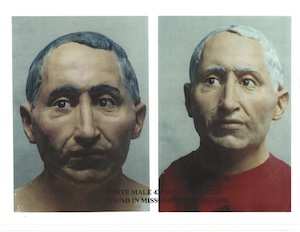Summary
In May 2000, the remains of an unidentified individual were discovered by fishermen on the south side of the Missouri River in Kansas City, Missouri. Investigators responded to the scene where they determined the remains were that of an adult white male. The remains were taken to the Jackson County Medical Examiner’s Office where it was determined that the man was between the ages of 43 and 55 years old, stood 5’6”, and weighed 121 pounds.
At the time of the man’s discovery, he was wearing faded Wrangler blue jeans, a large red short-sleeved tee shirt with a "Double Take" label, and a pair of size 8 black Pro Wing shoes with black socks. The man also had several tattoos including the letters "GG" on his right hand and a Pachuco cross tattoo on his left hand.
In April 2017, details of the case were entered into the National Missing and Unidentified Persons System (NamUs) as UP16567. A forensic sketch depicting the man's likeness was developed and released to the public in hopes that it would generate new leads in the case. Despite extensive efforts by law enforcement investigators to identify the man, no matches were found, and the case went cold due to a lack of investigative leads. 
In hopes that advanced DNA testing could help identify the man, the Jackson County Medical Examiner's Office submitted forensic evidence to Othram in The Woodlands, Texas. Othram scientists successfully developed a DNA extract from the forensic evidence, and then used Forensic-Grade Genome Sequencing® to build a comprehensive genealogical profile for the unknown man. Othram’s in-house forensic genetic genealogy team then used this profile to conduct genetic genealogy research, ultimately providing new investigative leads to law enforcement.
Using this new information, a follow-up investigation was conducted leading investigators to potential relatives of the man. Reference DNA samples were collected from the potential relatives and compared to the DNA profile of the unknown man. This investigation led to the positive identification of the man, who is now known to be Catajuan “John” Gonzalez, who was born in 1959.
The identification of Catajuan “John” Gonzalez represents the 16th case in the State of Missouri where officials have publicly identified an individual using technology developed by Othram. Most recently in Kansas CIty, Missouri, Harlan L. Serene was identified after 24 years.
